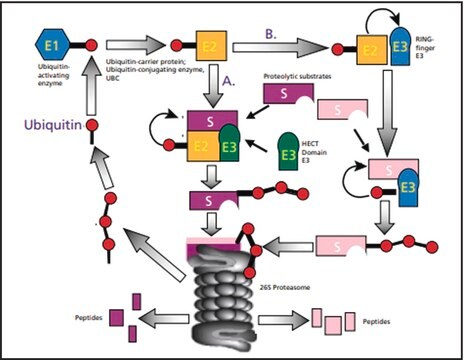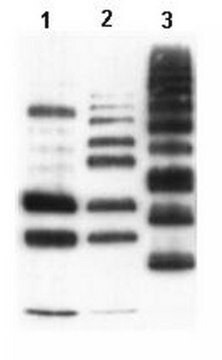Description générale
Anti-Ubiquitin, Cat. No. 07-375, is a rabbit polyclonal antibody that detects ubiquitin and ubiquitinylated proteins and is tested for use in Western Blotting.
Purified rabbit polyclonal antibody in buffer containing 0.1 M Tris-Glycine (pH 7.4), 150 mM NaCl with 0.05% sodium azide with 30% glycerol.
Spécificité
This rabbit polyclonal antibody specifically detects Ubiquitin.
Immunogène
Full-length ubiquitin is isolated from bovine erythrocytes.
Application
Anti-Ubiquitin, Cat. No. 07-375, is a rabbit polyclonal antibody that detects ubiquitin and ubiquitinylated proteins and is tested for use in Western Blotting.
Domaine de recherche
Signalisation
Sous-domaine de recherche
Ubiquitine et métabolisme de l'ubiquitine
Qualité
routinely evaluated by immunoblot from bovine erythrocytes, and ubiquitylated proteins in acid extracts from HeLa cells
Description de la cible
Ubiquitin (Ub) is initially produced as a 229 amino acids Polyubiquitin-B (UniProt: P0CG47) precursor protein encoded by the UBB gene (Gene ID: 7314) or a 685 amino acids Polyubiquitin-C precursor protein (UniProt: P0CG48) encoded by the UBC gene (Gene ID: 7316) chez l'être humain. Ub exists either covalently attached to another protein, or free (unanchored). When covalently bound, it is conjugated to target proteins via an isopeptide bond either as a monomer (monoubiquitin), a polymer linked via different lysine residues of the ubiquitin (polyubiquitin chains) or a linear polymer linked via the initiator methionine (Met) of the ubiquitin (linear polyubiquitin chains). Ub is linked covalently via its carboxyl terminus (Gly76) to lysine residues in target proteins. In a given target lysine residue can be linked to one single Ub molecule (monoubiquitylated) or to a chain of Ub molecules (polyubiquitylated). In a polyUb chain, Ub molecules can be linked through one of the seven lysine residues (K6, K11, K27, K29, K33, K48, and K63). Polyubiquitin chains, when attached to a target protein, have different functions depending on the lysine residue of the ubiquitin that is linked. For example, lysine 6-linked may be involved in DNA repair; lysine 11-linked is involved in endoplasmic reticulum-associated degradation (ERAD) and in cell-cycle regulation, and lysine 29-linked is involved in lysosomal degradation. Lysine 48-linked chains mark proteins for proteasomal degradation, while lysine 63-linked chains are involved in endocytosis, DNA-damage responses, and in signaling leading to activation of the transcription factor NF- B. Ubiquitin undergoes phosphorylation at the serine 57 by a ubiquitin kinase and this phosphorylation is an important modifier of ubiquitin function, particularly in response to proteotoxic stress. This phosphorylation may also be a deciding factor whether ubiquitin is recycled or degraded during multi-vesicular body sorting on endosomes. (réf. : Hepowit, NL., et al (2020). eLife 9; e58155; Lee, S., et al. (2017) eLife. 6; e29176).
Liaison
Remplace le(s) produit(s) suivant(s) : 04-454
Forme physique
Format : Produit purifié
Produit purifié sur protéine A
Protein A Purified immunoglobulin in PBS, 0.1% sodium azide, and 30% glycerol.
Stockage et stabilité
À conserver à -20 °C pendant 2 ans à compter de la date d'expédition. À diviser en aliquotes pour éviter les congélations et décongélations répétées. Pour récupérer le maximum de produit, centrifuger le flacon d'origine après décongélation et avant de retirer le capuchon.
Remarque sur l'analyse
Contrôle
N'importe quel tissu
Autres remarques
Concentration : pour connaître la concentration spécifique du lot, voir le certificat d'analyse.
Informations légales
UPSTATE is a registered trademark of Merck KGaA, Darmstadt, Germany
Clause de non-responsabilité
Sauf indication contraire dans notre catalogue ou toute autre documentation associée au(x) produit(s), nos produits sont uniquement destinés à la recherche et ne sauraient être utilisés à d'autres fins, ce qui inclut, sans s'y limiter, les utilisations commerciales non autorisées, les utilisations diagnostiques in vitro, les utilisations thérapeutiques ex vivo ou in vivo, ou tout type de consommation ou d'application chez l'être humain ou chez l'animal.











